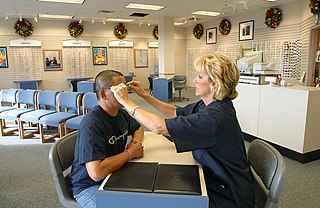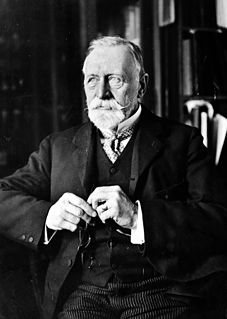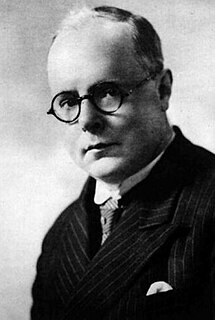Related Research Articles

Contact lenses, or simply contacts, are thin lenses placed directly on the surface of the eyes. Contact lenses are ocular prosthetic devices used by over 150 million people worldwide, and they can be worn to correct vision or for cosmetic or therapeutic reasons. In 2010, the worldwide market for contact lenses was estimated at $6.1 billion, while the US soft lens market was estimated at $2.1 billion. Multiple analysts estimated that the global market for contact lenses would reach $11.7 billion by 2015. As of 2010, the average age of contact lens wearers globally was 31 years old, and two-thirds of wearers were female.

Optometry is a specialized health care profession that involves examining the eyes and related structures for defects or abnormalities. Optometrists are health care professionals who typically provide comprehensive primary eye care.

An achromatic lens or achromat is a lens that is designed to limit the effects of chromatic and spherical aberration. Achromatic lenses are corrected to bring two wavelengths into focus on the same plane.

Park Lane is a major road in the City of Westminster, in Central London. It is part of the London Inner Ring Road and runs from Hyde Park Corner in the south to Marble Arch in the north. It separates Hyde Park to the west from Mayfair to the east. The road has a number of historically important properties and hotels and has been one of the most sought after streets in London, despite being a major traffic thoroughfare.

Oronhyatekha, , was a Mohawk physician, scholar, and a unique figure in the history of British colonialism. He was the first known aboriginal scholar at Oxford University; a successful CEO of a multinational financial institution; a native statesman; an athlete of international standing; and an outspoken champion of the rights of women, children, and minorities. He was once thought to be the first Native M.D. in Canada, having gotten his degree in 1866 from Toronto School of Medicine, but Peter Edmund Jones (Ojibwa), from New Credit, has been documented as having graduated a few months before Oronhyatekha. The fact that Oronhyatekha achieved these results during the Victorian era, when racism and pressure for First Nations peoples to assimilate were commonplace, has made him a figure approaching legend in some aboriginal circles.

A blue plaque is a permanent sign installed in a public place in the United Kingdom and elsewhere to commemorate a link between that location and a famous person, event, or former building on the site, serving as a historical marker. The term is used in the United Kingdom in two different senses. It may be used narrowly and specifically to refer to the "official" scheme administered by English Heritage, and currently restricted to sites within Greater London; or it may be used less formally to encompass a number of similar schemes administered by organisations throughout the UK.

The British Optical Association (BOA) was founded in February 1895 as the first professional body for ophthalmic opticians (optometrists) in the world. The British Optical Association Museum and Library was founded in 1901; it retains the BOA name but is now part of the College of Optometrists, located in Craven Street, Charing Cross, central London.

An optician, or dispensing optician, is a technical practitioner who designs, fits and dispenses lenses for the correction of a person's vision. Opticians determine the specifications of various ophthalmic appliances that will give the necessary correction to a person's eyesight. Some registered or licensed opticians also design and fit special appliances to correct cosmetic, traumatic or anatomical defects. These devices are called shells or artificial eyes. Other registered or licensed opticians manufacture lenses to their own specifications and design and manufacture spectacle frames and other devices.

Birt Acres was an American and British photographer and film pioneer. Among his contributions to the early film industry are the first working 35 mm camera in Britain (Wales), and Birtac, the first daylight loading home movie camera and projector. He also directed a number of early silent films.

Sir Thomas Clifford Allbutt was an English physician best known for his role as commissioner for lunacy in England and Wales 1889-1892, president of the British Medical Association 1920, inventing the clinical thermometer, and supporting Sir William Osler in founding the History of Medicine Society.
An eye care professional (ECP) is an individual who provides a service related to the eyes or vision. It is any healthcare worker involved in eye care, from one with a small amount of post-secondary training to practitioners with a doctoral level of education.

Dollond & Aitchison was one of the oldest chains of retail opticians in the United Kingdom, having been established in 1750. The business was absorbed into Boots Opticians in 2009 and stores were rebranded under the Boots Opticians name, completed in 2015.

Michael Hugh Hicks Beach, Viscount Quenington was a British politician.

One Great George Street (OGGS) is a four-domed grade II listed Edwardian building used as a conference and wedding venue just off Parliament Square in Westminster, London, England. The building is the global headquarters of the Institution of Civil Engineers (ICE); it was originally solely a venue for ICE members to meet informally and for conferences, but became available for public events in 1989. It is near the Houses of Parliament, Westminster Abbey, and St James's Park.

The Maughan Library is the main university research library of King's College London, forming part of the Strand Campus. A 19th-century neo-Gothic building located on Chancery Lane in the City of London, it was formerly the home to the headquarters of the Public Record Office, known as the "strong-box of the Empire", and was acquired by the university in 2001. Following a £35m renovation designed by Gaunt Francis Architects, the Maughan is the largest new university library in the United Kingdom since World War II.

The Honourable Charles Thomas Mills was Conservative Member of Parliament for Uxbridge, elected in January 1910 when he was the youngest MP. He was killed, serving as an officer with the Scots Guards on the Western Front.

Park Square is a Georgian public square in central Leeds, West Yorkshire. The square is grassed over and is a traditional Georgian park. The square is in Leeds' financial quarter and is surrounded by Georgian buildings, which are occupied as offices, many by barristers and solicitors.
Keith Hall may refer to:
Eye care in the United Kingdom is available through the National Health Service. Eye care in the community is almost entirely provided by optometrists in private practice. Specialist NHS services are provided from a small number of eye hospitals, and their staff often run clinics in general hospitals in their region.

Percy Lane Oliver is credited with founding the first volunteer blood donation service. A layman, Oliver was working for the Camberwell division of the Red Cross in 1921 when he responded to a call from a local hospital requesting an urgent blood donation. This experience led him to organise a panel of donors whose blood types were known and who were available to donate on request. The donors, unusually for the time, were not paid. Oliver's blood donation service, which he ran out of his London home, would grow from 20 volunteers at its inception to approximately 2700 in 1938. His model of voluntary blood donation was adopted throughout Britain and in other countries.
References
- ↑ Contact Lens History http://www.andrewgasson.co.uk/pioneers_clifford_hall.htm Archived 2016-03-03 at the Wayback Machine
- ↑ Keith Clifford Hall collection http://www.bcla.org.uk/en/membership/membership-benefits/access-to-free-or-discounted-publications/keith-clifford-hall-collection.cfm.
- ↑ City of Westminster green plaques "Westminster City Council - Green Plaques Scheme". Archived from the original on 16 July 2012. Retrieved 7 July 2011.